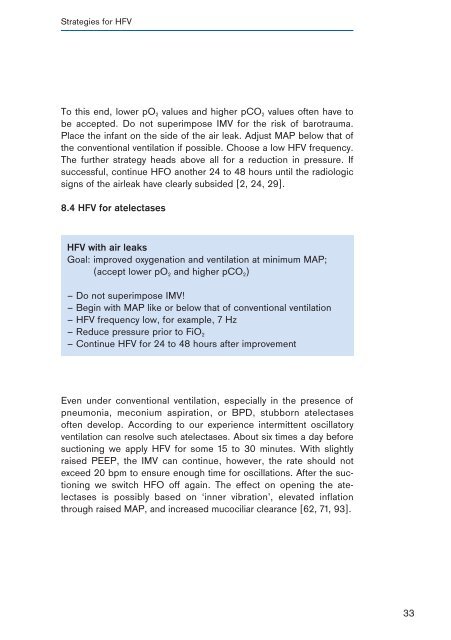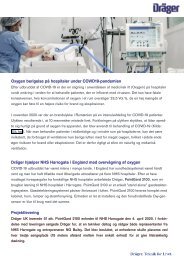High-Frequency Ventilation- Basics and Practical Applications
Create successful ePaper yourself
Turn your PDF publications into a flip-book with our unique Google optimized e-Paper software.
Strategies for HFV<br />
To this end, lower pO 2 values <strong>and</strong> higher pCO 2 values often have to<br />
be accepted. Do not superimpose IMV for the risk of baro trauma.<br />
Place the infant on the side of the air leak. Adjust MAP below that of<br />
the conventional ventilation if possible. Choose a low HFV frequency.<br />
The further strategy heads above all for a reduction in pressure. If<br />
successful, continue HFO another 24 to 48 hours until the radiologic<br />
signs of the airleak have clearly subsided [2, 24, 29].<br />
8.4 HFV for atelectases<br />
HFV with air leaks<br />
Goal: improved oxygenation <strong>and</strong> ventilation at minimum MAP;<br />
(accept lower pO 2 <strong>and</strong> higher pCO 2 )<br />
– Do not superimpose IMV!<br />
– Begin with MAP like or below that of conventional ventilation<br />
– HFV frequency low, for example, 7 Hz<br />
– Reduce pressure prior to FiO 2<br />
– Continue HFV for 24 to 48 hours after improvement<br />
Even under conventional ventilation, especially in the presence of<br />
pneumonia, meconium aspiration, or BPD, stubborn atelectases<br />
often develop. According to our experience intermittent oscillatory<br />
ventilation can resolve such atelectases. About six times a day before<br />
suctioning we apply HFV for some 15 to 30 minutes. With slightly<br />
raised PEEP, the IMV can continue, however, the rate should not<br />
exceed 20 bpm to ensure enough time for oscillations. After the suctioning<br />
we switch HFO off again. The effect on opening the atelectases<br />
is possibly based on ‘inner vibration’, elevated inflation<br />
through raised MAP, <strong>and</strong> increased mucociliar clearance [62, 71, 93].<br />
33


















